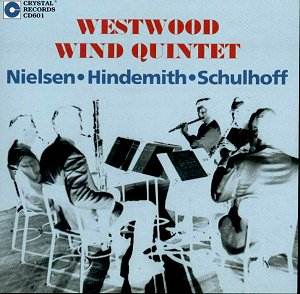Crystal is revisiting its LP catalogue. In its
day – and its day was 1966-68 - this compilation had very little
competition but there are now a number of choices available in
an increasingly competitive market. What makes this disc of value
is the playing, which is tonally eloquent and technically adept
and the still fine sounding recording. Both the Hindemith and
Nielsen have been coupled by the Bergen, Prague New York and Swiss
Wind Quartets. The old Melos version of the Nielsen from 1967
may still be around and the Oslo Wind Quartet have given a good
account on Naxos. The Schulhoff however is still something of
a rarity. Lammers-Hermann and Groth have played it on Schwann
and the Divertimento Trio on Fermate have also recorded it. No
one has coupled all three of these works apart from the Westwood
– appositely since they were all written between 1922 and 1926.
Whenever I listen to the Nielsen Quintet I dig
out the 1936 recording made by the dedicatees, the Wind Quintet
of the Royal Orchestra Copenhagen (recently available on Claremont
and Danacord). Four of the original members were still there,
fourteen years after they’d premiered it, and the points of departure
between their rubato, rich and fluctuating sense of motion and
the modern single tempo performances are always instructive, as
here. The Westwood are more gimlet-eyed and sound more fresh than
the older players; there’s a sense of undeviating direction and
a build up of steam that’s attractive if not perhaps entirely
alive to any darker purpose. The Minuet though is excellently
phrased and bright and alertly played. It’s in the Praeludium
and Variational finale that things really do diverge. Interestingly
first recorded performances tend to be brisker and less indulgent
but here the Westwood are far more direct and speedy than the
1936 Quintet. I doubt however if anyone but the Wind Quintet of
the Royal Orchestra Copenhagen has made this movement sound quite
so sinuous and insinuating in its opening paragraphs – it’s a
pity that their recording was always a bit dimly recessed – or
has conveyed the slow moving grandeur better. Most contemporary
quintets stress the public "discordance" of this movement
but the 1936 recording seems to absorb these elements into the
flux of the work without undue show. By contrast the Westwood
are just that bit too sharply etched, don’t prepare for the baroque
themes quite well enough, fail to unfold the music with imperceptible
logic and sound just a mite too exterior.
They are more at home in the Hindemith, which
receives a generally fine performance. They are particularly successful
in the mordant little Waltz second movement and take care to ensure
that the oboe tune remains in tempo in the third movement. Their
finale (Sehr lebhaft) is charmingly done, well balanced
and at a good tempo. The Schulhoff Divertissement is written for
oboe, clarinet and bassoon and is in seven brief movements. There’s
a loquacious Overture with fugal pretensions and plenty of witty
registral games, a lazy, languorous and pert Romanzero. The
Charleston is a glinting, darting, hinting one that never gets
explicit (unlike say the Martinů
Charleston in La Rêvue de cuisine,
which dates from five years later, 1927). The Theme and Variations
are excellently accomplished in this performance and the curiously
named Florida movement has strong unison work. This is a fine
performance of an uneven but likeable work that should be heard
more often.
As such it may tip the scale if you want the
Schulhoff. For the Nielsen I’d go elsewhere but there are two
strong performances here and the sound quality has scrubbed up
very nicely indeed.
Jonathan Woolf
